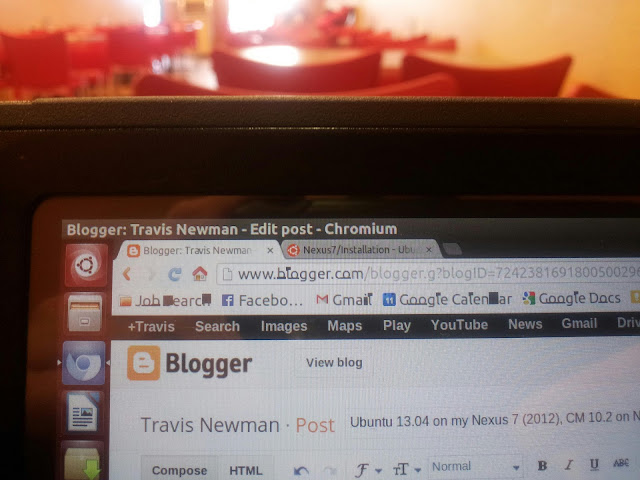This is something that Ubuntu is already working on, and something you can partially get away with in Android.
Right now, Ubuntu is working on a mobile version of their operating system, Ubuntu Touch. While it can be installed on a variety of devices right now, much of the functionality is missing. Lots of dummy content. Think of a phone that’s on display in a retail outlet. You can get Ubuntu Touch today, but its not ready to be your daily mobile OS… yet.
Ubuntu isn’t just making an OS for mobile, they’re doing something more.
Ubuntu Touch (from my understanding) IS the full version of Ubuntu, just with a more touch-friendly interface. Applications that you run on your phone are the same versions that you would run on the desktop, again, with a more touch friendly interface.
The reason for this is because Ubuntu Touch wants to be your desktop. When you plug a display into your Ubuntu Touch-running phone, you’re at the Ubuntu Desktop. Attach a keyboard and mouse (or pair wirelessly via Bluetooth) and you have a full desktop experience served up by your phone.
To my knowledge, Ubuntu is the only project out there like this. The key to this whole setup is video out. And currently, many handsets do have video out (MHL).
So video out is an output but your would-be desktop needs inputs: Keyboard and mouse.
Recently, I got a Motorola Xoom Bluetooth keyboard. It’s compact, made for Android, and fairly cheap ($30 w/ shipping on eBay). I especially like it because the Android-specific shortcut keys work. I can press home and it takes me back to the home screen, the gmail button opens gmail, etc. Its pretty neat.
What i’m discovering though, is that it is very possible to navigate around the UI with just a keyboard. Additionally, some apps are nicer about this than others. Of course, a Bluetooth mouse would make this issue disappear. But as it stand’s right now, I don’t, and for my purposes I’m not sure I need it. Using a mouse requires extra desktop real estate, plus I’m an HID snob and don’t like how Bluetooth mice are weighted (wired mice are lighter). Also, it’s one more thing to carry.
Right now, I’m typing this on my Nexus 7 (currently offline because this room is walled with lead… or it might as well be) with my Bluetooth keyboard in the Blogger app. I’m sitting comfortably away from the screen and the text is readable to me, although it may be harder to read for someone with less than perfect vision. I don’t think its significantly smaller than text on a laptop or a desktop screen.
How is this different than a laptop?
It is more limited, for sure, because I can’t go and get any program or application off the internet and install it, it needs to be made for Android. But, so long as it provides the same needed functionality, then what difference does it make? I can write papers, listen to music, write emails, surf the web, chat, get on Facebook, and watch movies. I’m still feeling it out, but so far, this is a pretty neat solution.
To-Do:
Figure out how to open, edit, save files on the phone. And not just “files” that reside inside of apps (documents in Google Drive, posts in Blogger), files that I can see when I plug my phone into my computer, files that I can send as attachments. You know, file files. Living in the cloud is fine, but I would like have the ability to be really capable.
Printing is another thing. I know that it’s possible. Waaaaay back when, when my good buddy Patrick had his G1, he was able to print to an HP LaserJet that was connected to the network. Printing could be an interesting problem because of drivers. However, if the printer is shared over the network, depending on how its advertised, it might be driver agnostic. I’ll need to look into the printing problem further, because that is a very fundamental function of a desktop computer.





